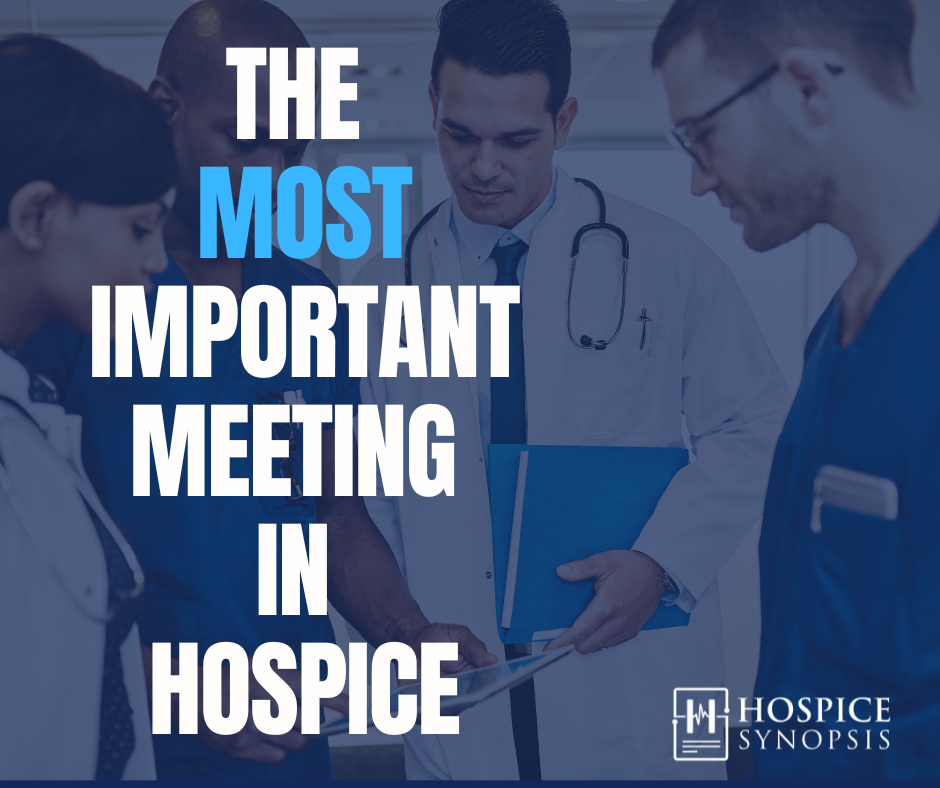What Is the IDG? Meet the Real Hospice Team – And What Happens When We Get It Wrong

If hospice is how we show up for the dying, then IDG is how we show up for each other. The patient never hears the meeting, but they feel its echo. In this IDG, someone says the patient’s name aloud—a small act that makes the care real.
The Interdisciplinary Group—IDG—holds hospice together. Many reduce IDG to a Medicare checkbox. But those who’ve been around know better: IDG builds the care plan. It shapes decisions, aligns teams, and forms the clinical backbone of everything that follows. At its best, IDG is our most powerful intervention. As Eduardo Bruera, M.D. notes, “The IDT is not just a regulatory structure. It’s the platform from which we teach, coordinate, and care.” [Bruera, 2019]
“At this table, hospice stops being paperwork—and becomes care.”
This blog is part of your IDG orientation—and a guidepost for how we think, lead, and care together. Most IDGs don’t feel like this yet. But they could.
Why IDG Exists (And Why It Still Matters)
The IDG originated as a Medicare requirement under 42 CFR §418.56. It mandates that every patient’s plan of care be reviewed at least every 15 days. The National Consensus Project emphasizes, “Interdisciplinary team function is not optional. It is a standard of care.” [NCP Guidelines, 4th Edition] But beyond regulation, the real purpose is collaboration. It’s where we build clarity, align care, and catch what’s being missed.
The goal is a unified patient story: the CTI, med list, diagnoses, visit notes, and care goals should all tell the same story. If they don’t, we fix it in IDG. It protects the benefit by catching what the chart misses. Done well, IDG isn’t a checkpoint—it is the intervention. If your CTI doesn’t match your last visit note, you don’t have a plan. You have a denial waiting. And when it isn’t done well? Care becomes fragmented. The table breaks before anyone sits down. As Fast Facts #82 reminds us, “Every hospice patient is a team responsibility. That’s not sentiment—it’s statute.”
In one IDG, no one flagged the daughter’s nonverbal distress. A crisis followed that could have been prevented. A strong IDG prevents ER transfers, reduces caregiver burnout, and closes chart gaps before surveyors find them. A weak one multiplies crises and denials.
This is the heartbeat of hospice: when the chart, the voices, and the care plan align, IDG itself becomes the intervention. Everything else—flow, roles, regulations—is in service of this: IDG itself is the care. Today’s hospices face staffing shortages and virtual meeting fatigue, which can strain IDG collaboration. Yet, these challenges make the IDG’s role even more critical. A strong IDG adapts to virtual platforms, ensures remote voices are heard, and maintains focus amid lean teams, turning constraints into opportunities for clarity and connection.
What a Strong IDG Prevents:
- Unnecessary ER transfers
- Survey citations from chart gaps
- Caregiver collapse from unaddressed burden
Who’s at the Table—and Why
Clinical Voices (RN, Physician, Admissions Nurse)
– Track meds, trajectory, and Eligibility. Psychosocial and Spiritual Voices (SW,
Chaplain, Volunteer/Bereavement)
– Name family strain, grief risk, cultural distress.
Operational and Daily Voices (CNA, Dietitian, Team Assistant, Administrator) –
Reveal burdens at the bedside and smooth logistics.
Each role sees what others can’t. IDG only works when those fragments become one story. Every voice matters. So does silence. Equity in IDG isn’t just about services—it’s about whose story gets heard and whose concerns are believed.
Running the Meeting: Order, Flow, and Best Practices
Principle: Start with closure (deaths, discharges) before planning forward (admissions, recerts). Practice: follow the same order every time. Consistency saves energy and closes gaps.
That flow saves energy and preserves focus. And when flow works, it prevents gaps that would otherwise ripple to the bedside. But the flow fails when voices are missing. When the meeting is led by one person, or none at all. Some weeks the room goes quiet.
That silence speaks.
Ensuring Every Voice Is Heard
IDG thrives when every team member’s perspective is valued, but power dynamics or time constraints can silence quieter voices, like those of aides or volunteers. To foster equity:
Assign a Facilitator: Designate a neutral leader to encourage participation and ensure no one dominates. Rotate facilitation weekly to build ownership.
Use Structured Prompts: Ask each role specific questions, like “What changes have you noticed in the patient’s home?” for aides, or “What unmet needs have you observed?” for volunteers.
Pause for Reflection: Build in a brief pause after each patient discussion to invite input from quieter members. One aide said, “I didn’t speak up until someone asked what I saw.”
Inclusive facilitation turns silence into insight, ensuring the care plan reflects the full patient story.
What Changes Monday Morning
This meeting anchors the care. Done right, IDG changes how we show up at the bedside and on the phone.
Next IDG—what will you bring beyond data? If this feels out of reach, you’re not alone. The work is making it real. Does your plan of care reflect this week’s symptoms? Which voice didn’t speak this week—and why? What would your next IDG sound like if it truly reflected your patient’s story? As Michael Kearney, M.D. writes, “The team must metabolize the suffering it absorbs.”
Monday Morning Toolkit
Script Prompt: “What did you see this week that no one else could have seen?” (ask aides/volunteers)
Checklist Trigger: CTI = Visit Notes = Care Plan. If not, fix it in IDG today.
Equity Practice: Rotate who opens each case—sometimes the aide, sometimes the chaplain.
Compliance Check: If your IDG care plan isn’t signed, synced, and accessible by tomorrow, it isn’t real.
Three Key Insights
1. The IDG is where hospice’s philosophy becomes action.
2. Good IDG flow depends on good pre-work and care plan alignment.
3. Every meeting is a crucible—patterns surface, gaps close, clarity becomes care.
Two Actionable Ideas
1. Build a recurring patient checklist for high-benefit-period reviews.
2. Start your next IDG meeting with the BigR question: “What is the biggest risk or concern for this patient right now?” This focuses the team on critical issues and sparks meaningful discussion.
One Compassionate Call to Action
Let your IDG table reflect what hospice stands for: clarity, courage, and collective care.
Bibliography
Bruera, E. (2019). The palliative care team as a teaching platform. Journal of Palliative
Medicine, 22(5), 437–438. https://doi.org/10.1089/jpm.2019.0146
Cassell, E. J. (2004). The nature of suffering and the goals of medicine (2nd ed.). Oxford University Press.
Centers for Medicare & Medicaid Services. (n.d.). 42 CFR §418.56 – Interdisciplinary group, care planning, and coordination of services. https://www.ecfr.gov/current/title-42/chapter-IV/subchapter-B/part-418
Fast Facts #82. (2001, revised 2015). The interdisciplinary team. Palliative Care Network of Wisconsin. https://www.mypcnow.org/fast-fact/the-interdisciplinary-team/
Fast Facts #124. (2004, revised 2019). Interdisciplinary team communication. Palliative
Care Network of Wisconsin. https://www.mypcnow.org/fast-fact/interdisciplinary-team-communication/
Kissane, D. W., and Bultz, B. D. (2016). Psychosocial oncology: The 6th vital sign (2nd ed.). Springer.
National Coalition for Hospice and Palliative Care. (2018). Clinical practice guidelines for quality palliative care(4th ed.). https://www.nationalcoalitionhpc.org/ncp/
Wittenberg, E., Goldsmith, J., and Ragan, S. L. (2020). Communication in palliative nursing. Oxford University Press
Glossary Entries
Interdisciplinary Group (IDG) (new) – The hospice team mandated by CMS to review and direct the plan of care at least every 15 days. The IDG includes, at minimum, the hospice physician, RN, social worker, and chaplain, but also draws on aides, volunteers, and other roles. The IDG is both regulatory and relational—it synthesizes observations into one patient story and protects the hospice benefit.
Certification of Terminal Illness (CTI) (updated) – A required hospice documentsigned by a hospice physician and attending physician (if any) that certifies a life expectancy of six months or less. The CTI must align with visit notes, diagnoses, and the care plan; discrepancies risk denial.
Care Plan (Hospice Context) (updated) – The unified clinical roadmap for each patient, built and updated in IDG. It integrates diagnoses, goals, interventions, and anticipated needs. A care plan must reflect the current patient reality—not just chart fragments—to remain compliant and effective.
IDG Flow (new) – The standard progression of cases in IDG (deaths → discharges → admissions → recerts → long-stay patients) designed to conserve energy and close chart gaps before they reach the bedside.
Equity Seat (new) – The principle that every IDG role has indispensable insight; ensuring each role has space to speak prevents blind spots and strengthens care.
Sparks
1. What if the most powerful intervention in hospice wasn’t a medication, but a meeting?
2. In your last IDG, whose voice carried—and whose was missed?
3. Does your care plan read like one story, or ten different charts?
4. When the chaplain speaks, does the physician lean in—or check out?
5. If IDG is a mirror, what does your table reflect about your hospice?
Sidebar
“In one IDG, a chaplain flagged a daughter’s ambivalence about caregiving. That led to an earlier MSW visit, a new caregiver contract, and an avoided crisis. This is IDG. When it works.”
And this is also why IDG protects the hospice benefit—it catches what gets missed, before the chart does.

Leave a Reply